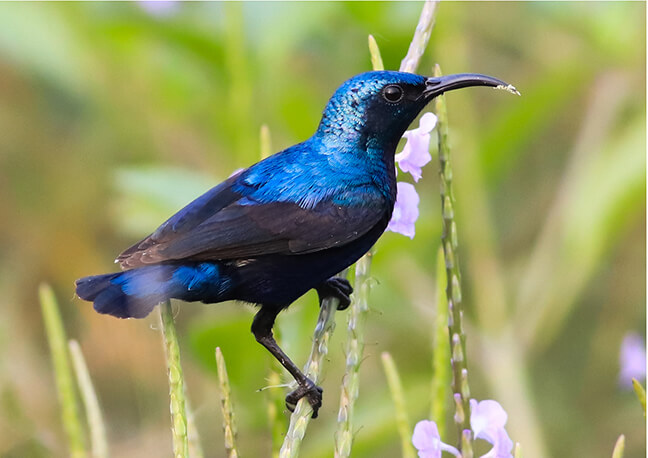Registered with the Registrar of Newspapers for India under R.N.I 53640/91
Vol. XXX No. 2, May 1-15, 2020
Lockdown Safari
By Varsha Venugopal
 From L-R: Black-rumped Flameback, Green Bee-eater, Rose-ringed Parakeet. Photo courtesy, Umesh Mani
From L-R: Black-rumped Flameback, Green Bee-eater, Rose-ringed Parakeet. Photo courtesy, Umesh Mani
 Coppersmith Barbet. Photo courtesy, Umesh Mani
Coppersmith Barbet. Photo courtesy, Umesh Mani Rufous Treepie. Photo courtesy, Umesh Mani
Rufous Treepie. Photo courtesy, Umesh Mani Purple Sunbird. Photo courtesy, Umesh Mani
Purple Sunbird. Photo courtesy, Umesh ManiWhile studies are yet to investigate the actual impact of the lockdown on city pollution, the lack of traffic alone seems to have reduced air and noise pollution levels in Chennai. A pleasant consequence has been an increased awareness and appreciation of our city’s rich urban wildlife. Chennaiites are spotting colourful birds, butterflies, and beetles that they have never seen before, in their own backyards. Is it a sign of nature reclaiming urban spaces? Not really, say experts. The beauty has always been there. We just haven’t noticed it before.
“With the reduction in noise pollution, we can hear bird calls more clearly,” said Umesh Mani of Madras Naturalists’ Society, a veteran birdwatcher. “One can hear koels calling to each other, for instance, and the chirping of barbets and sunbirds. We’re seeing more woodpecker activity and noticing the movement of parakeets. People are observing a lot more compared to before,” he explained. With more and more people rediscovering the joy of nature watching, MNS has seen a welcoming spike of new participants, especially children, who are curious to learn more about the non-human inhabitants sharing the city.
It’s not just birds that they’re sighting either — they’re spotting butterflies, frogs, and even some interesting insects. The MNS is encouraging members of all ages with activity guides to spot all creatures great and small, from pharaoh ants and potter wasps to bark-geckos and nuthatches.
“I’m noticing more small creatures than before, like dung beetles crawling in the middle of the road,” said Dr. Susy Varughese of IIT Madras.
She added that deer are moving around the campus peacefully in larger herds, with no traffic or human activity to send them scattering. Like Umesh, she also pointed out that the bird calls of robins, warblers, and bulbuls sounded clearer as well.
Apart from the colourful urban wildlife, the city skies are glowing in new-found limelight, too. More people are looking up at the heavens, trying to snap a picture of the Milky Way or the moon. Astronomer Neeraj Ladia, Head of Space India Chennai, attributed the city’s clearer skies to a decrease in dust pollution. “While there hasn’t been a drastic change in light pollution, the drop in dust pollution has made the skies brighter,” he said.
 Venus meets Pleiades. Photo courtesy, Neeraj Ladia, Head of Space India, Chennai.
Venus meets Pleiades. Photo courtesy, Neeraj Ladia, Head of Space India, Chennai.As luck would have it, it is an interesting time to explore amateur stargazing — in April, for instance, the skies were lit up by the beautiful Lyrids meteor showers and there was a spectacular conjunction of the planet Venus and the Pleiades star cluster (a.k.a the Krittika constellation), too. “Members have been seeing Venus, Jupiter, and Saturn with a pair of binoculars,” said Neeraj.
As Chennai’s residents learn to enjoy the natural beauty around them, one wonders how much of this we can retain once the lockdown lifts, especially as the city ramps up commercial and development activity to make up for lost time. “That’s the fear,” admitted Umesh, as he shared his concern that aggressive industrial activity might end up doing more damage to our urban ecosystem. Let’s hope we can chart a gentle return to normal life, holding onto the good things as the lockdown phases out.

